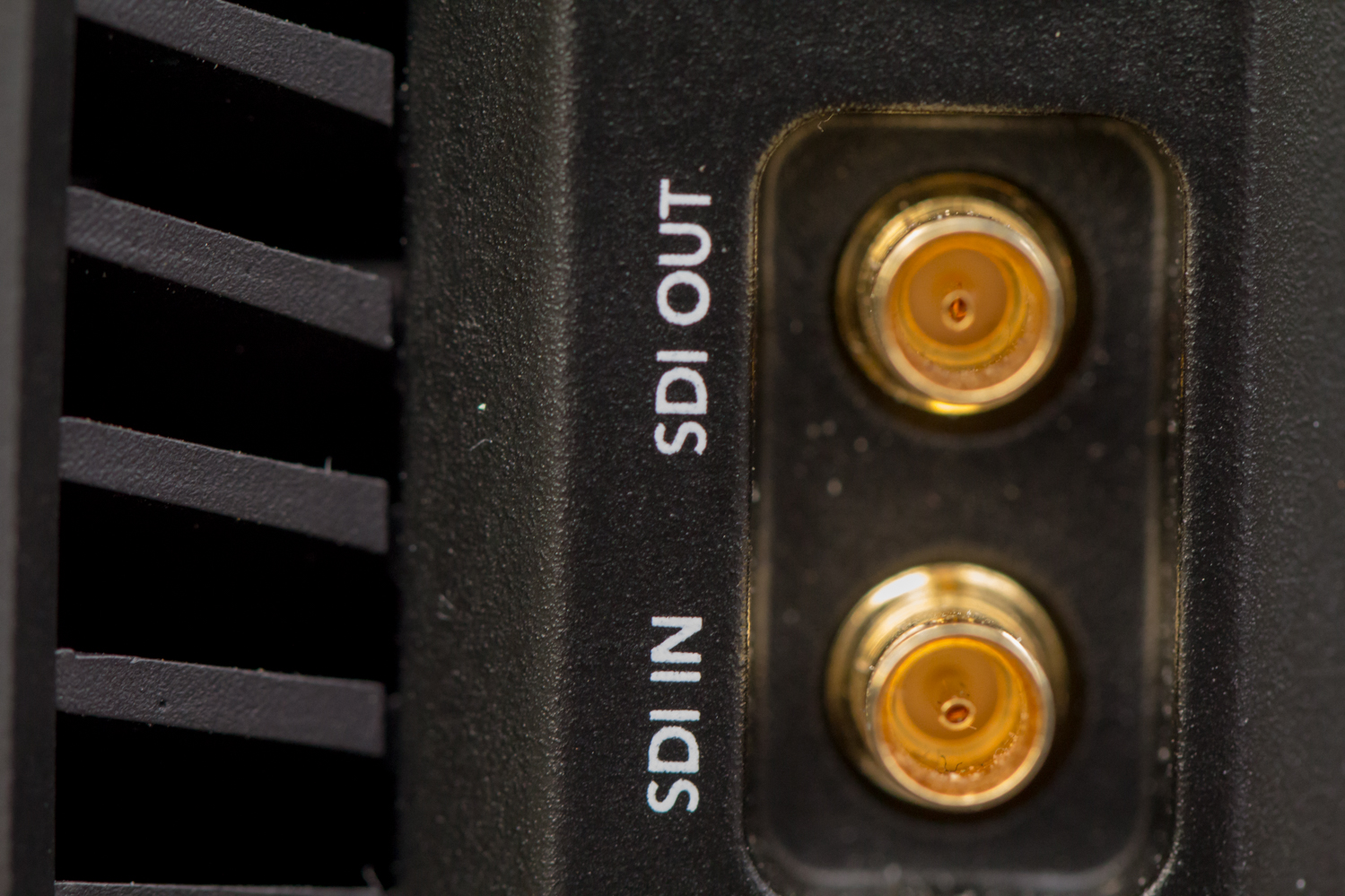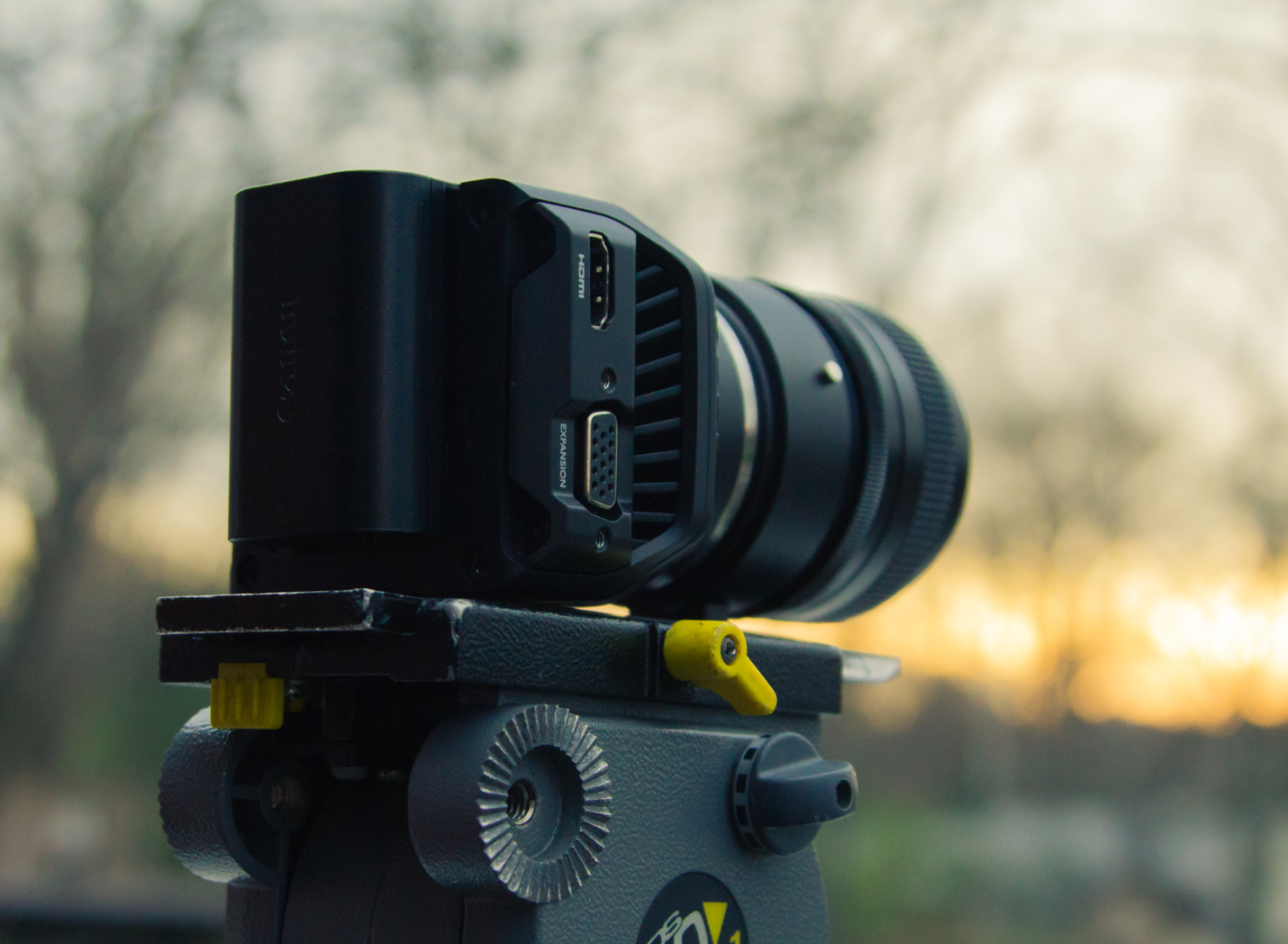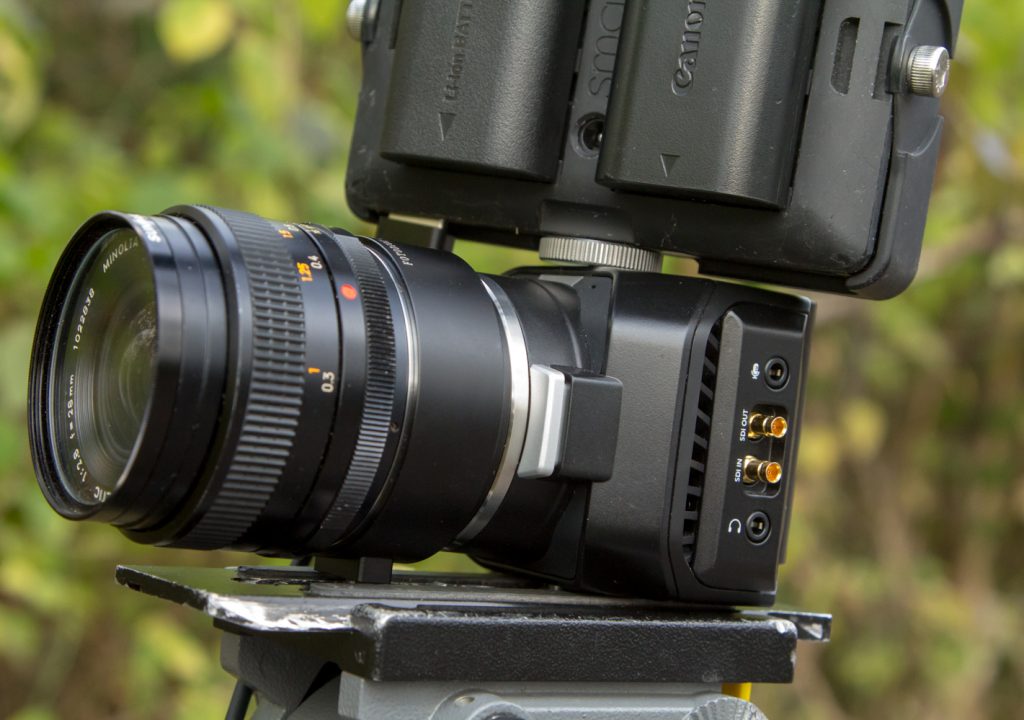Blackmagic’s smallest studio camera proves to pack a big punch with loads of features.
It’s small, it shoots 4K, and it has the capability to deliver great pictures. It’s not very often I get to play with cameras the size of my fist, GoPros aside. So how does Blackmagic’s Micro Studio Camera measure up? In many ways, the camera pays off bigger than its diminutive size suggests. Other times, it can cause a bit of curiousity. What did Blackmagic get right? First off, they took the original Studio Camera and made it much more a flexible camera. With an electronic viewfinder and a recorder this “Studio” camera can definitley play outside whereas the original, and it’s reflective screen, does best inside.

PICTURE QUALITY
 If you shot on the older Studio Camera you might be pleasantly surprised. The image out of the Micro Studio Camera is better. I feel like the Micro Studio Camera might be a touch more light sensitive, and the color feels a bit more organic. When I shot footage outside, and inside, I didn’t have much of an issue with dynamic range or color. Yet, temper your wild enthusiasm. The image off this camera is a lot more TV feeling than it is filmic. I think we can expect the Micro Cinema Camera to be the more filmic of the two Micro cameras from Blackmagic.
If you shot on the older Studio Camera you might be pleasantly surprised. The image out of the Micro Studio Camera is better. I feel like the Micro Studio Camera might be a touch more light sensitive, and the color feels a bit more organic. When I shot footage outside, and inside, I didn’t have much of an issue with dynamic range or color. Yet, temper your wild enthusiasm. The image off this camera is a lot more TV feeling than it is filmic. I think we can expect the Micro Cinema Camera to be the more filmic of the two Micro cameras from Blackmagic.
WHY SO SMALL
Blackmagic is calling the Micro Studio Camera the world’s smallest Ultra HD Live Studio Camera. The size of the Micro Studio Camera lends itself to tight places giving shooters the opportunity to shoot from unique perspectives. It is no coincidence the rear of the Micro Studio Camera body fits perfectly into a corner with the 45 degree sides of the camera snug up to the corner of a room. It’s those little thought out details that make the Studio Camera unique. I can see a live broadcast crew placing the Micro Studio Camera in many interesting locations.
 Yet, the small size means small buttons, and small buttons means operating any camera can be somewhat of a chore. However, this camera is not meant to be your run & gun choice. Blackmagic made the 4K Micro Studio Camera to fill a niche. When I operated the camera, and dived into the menus, I found my fingers accidently hitting the wrong buttons. After some experience, muscle memory will help a shooter move through the buttons faster. I’m also not a huge fan of the buttons on the front of the camera, but I think they’re positioned there so you can place the camera in a corner and still dive into the menu. In that case, this is a smart, thought out, design by Blackmagic.
Yet, the small size means small buttons, and small buttons means operating any camera can be somewhat of a chore. However, this camera is not meant to be your run & gun choice. Blackmagic made the 4K Micro Studio Camera to fill a niche. When I operated the camera, and dived into the menus, I found my fingers accidently hitting the wrong buttons. After some experience, muscle memory will help a shooter move through the buttons faster. I’m also not a huge fan of the buttons on the front of the camera, but I think they’re positioned there so you can place the camera in a corner and still dive into the menu. In that case, this is a smart, thought out, design by Blackmagic.
LENS CHOICE
The only problem with the full remote capability of the Micro Studio Camera is the lack of a large number of compatible lenses when remotely controlling the camera. Active Micro 4/3 photo zoom lenses are designed to be small, light weight, but tend to be a bit on the slow side. If you’re using the expansion port and you want to remotely control your lenses you’re stuck with only a few options. However, you can stray away from only using M4/3 lenses as long as you have no need to remotely control zoom, iris, and focus. The M4/3 mount is highly adaptable. Metabones makes a speedbooster and a regular EF-Mount adapter, Nikon F Mount adapter, and for not a ton of money one can place a PL lens adapter on this tiny camera and shoot with higher quality cinema lenses.
INS/OUTS
 For once Blackmagic placed a full-sized HDMI port on the Micro Studio Camera. On the other side of the camera, they’ve placed Micro SDI, Micro DIN, connections. Because of the small size of the camera these connections make complete sense. A full-sized SDI connection would take at least twice the space. One thing to be aware of with the Micro DIN connections and HDMI port on the camera: the cable comes straight out and seems to be in the place to break or damage the connections. Be careful, protect those cables, and protect those connections.
For once Blackmagic placed a full-sized HDMI port on the Micro Studio Camera. On the other side of the camera, they’ve placed Micro SDI, Micro DIN, connections. Because of the small size of the camera these connections make complete sense. A full-sized SDI connection would take at least twice the space. One thing to be aware of with the Micro DIN connections and HDMI port on the camera: the cable comes straight out and seems to be in the place to break or damage the connections. Be careful, protect those cables, and protect those connections.
AERIAL/GIMBAL PHOTOGRAPHY
Could this camera fly on an octocopter, on a brushless gimbal? Absolutely. The small size and the small sensor all lend themselves to both of these shooting situations. On flying the Micro Studio Camera on a Drone, the 4K can only help. What’s even more helpful is the expansion port. Now drone operators can fully control a the Micro Studio Camera remotely. Check out the video my friend Matt Barker of Blackhawk Cinema made while testing his Micro Studio Camera.
USING WITHOUT BLACKMAGIC’S VIDEO ASSIST
 The 4K Micro Studio Camera shoots 4K, but Blackmagic has no way of recording the camera’s 4K footage. The Blackmagic Video Assist, which is a great monitor/recorder, only records 1080HD. What is a shooter to do? There are a few 4K recorders/monitors out already at different costs and features. Atomos and Convergent Design make good 4K recorders. Just remember, the 4K output on the Micro Studio Camera is only reserved for those Micro SDI connections, and not for the HDMI connection.
The 4K Micro Studio Camera shoots 4K, but Blackmagic has no way of recording the camera’s 4K footage. The Blackmagic Video Assist, which is a great monitor/recorder, only records 1080HD. What is a shooter to do? There are a few 4K recorders/monitors out already at different costs and features. Atomos and Convergent Design make good 4K recorders. Just remember, the 4K output on the Micro Studio Camera is only reserved for those Micro SDI connections, and not for the HDMI connection.
LP-E6 CANON BATTERIES
I am so happy to see Blackmagic move away from internal batteries on their cameras. They are heavy and they add, what I think can be, unnecessary size and weight to a camera. In many ways the internal battery is great when you find yourself in a pinch, but, for me, those situations are few and far between. LP-E6 Canon batteries, I have many of these sitting around my office. I assume many shooters have a few extra LP-E6 batteries hanging around. Using these batteries is a smart decision by Blackmagic: Easily available, relatively cheap, and small. The small size of the batteries also help keep the 4K Micro Studio Camera small too. If this camera had an internal battery the size might be twice as large. Battery life while shooting? Best to have a handful on hand because this camera burns through a battery in a bit over an hour.
LASTING THOUGHTS
This is a tiny camera capable of fullfilling a handful of roles well. It can be used as a live broadcast camera and works especially well with Blackmagic’s ATEM Switcher. The picture is decent, it’s a little less dynamic range than the Blackmagic Pocket Cinema Camera, and the light sensitivity is alright. Remember, this camera was made for live broadcasts, and live broadcasts tend to be lit. When shooting outside I enjoyed this camera. I loved the color and the look. Plus, what’s not to love about a camera you can place just about anywhere.
4K MICRO STUDIO CAMERA TECH SPECIFICS
- Sensor Size – 13.056 x 7.344 mm
- Lens Mount – Active MFT
- Resolutions & Frame Ratee
- 3840 x 2160p 23.98/24/25/29.97/30
- 1920 x 1080p 23.98/24/25/29.97/30/50/59.94/60
- 1920 x 1080i 50/59.95
- Connections
- SDI VIDEO OUTPUT – 1 x 6G-SDI (DIN 1.0/2.3 connector), 10-bit 4:2:2
- SDI VIDEO INPUT – 1 X 6G-SDI (DIN 1.0/2.3 connector), 10-bit 4:2:2
- SDI AUDIO OUTPUT – 2-channel embedded audio support in SDI stream
- Analog Audio Input – 1 x 3.5 mm stereo mini jack (mic or line level)
- Analog Audio Output – 1 x 3.5 mm stereo connector (for stereo headphones, compatible with iPhone headsets for talkback)
- Expansion Port
- 1 x DB-HD15 serial connector supports
- LANC input
- 1 x S.Bus channel input
- PTZ output
- Genlock input
- B4 lens control output
- 1 x DB-HD15 serial connector supports
- Remote Control
- Over SDI via ATEM Switcher CCU Protocols or via expansion port using LANC or S.Bus
To learn more about Blackmagic’s 4K Micro Studio Camera go here:

Filmtools
Filmmakers go-to destination for pre-production, production & post production equipment!
Shop Now













